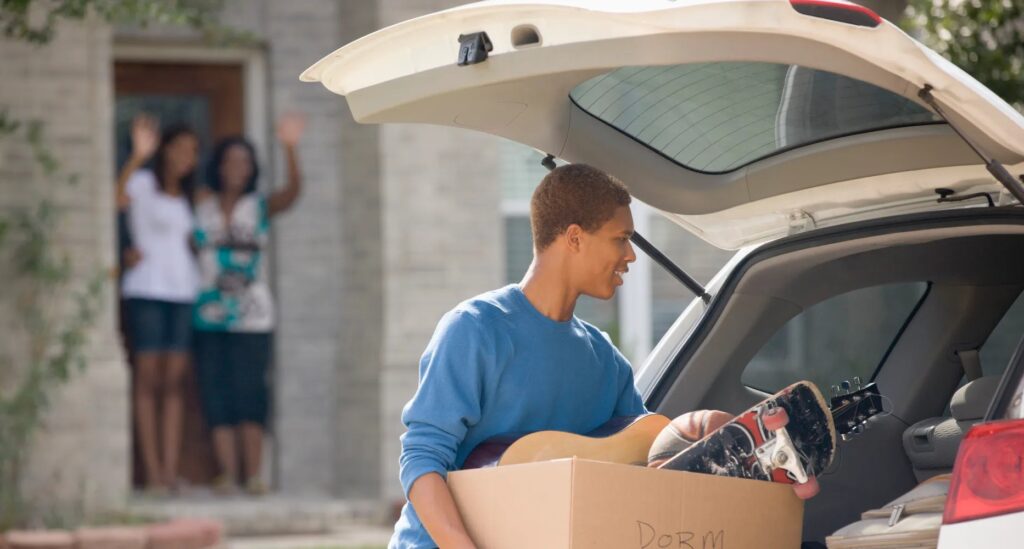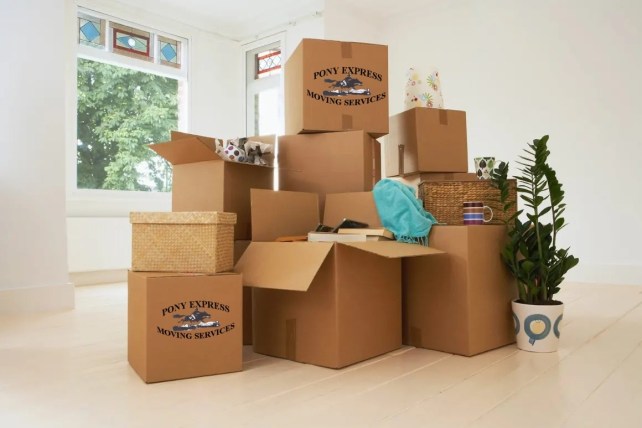So you’ve decided to leave the nest? Congratulations! Moving out of your parents’ house is a big deal. It’s a process that requires plenty of careful planning, consideration, and “adulting.” To help you successfully move out of your parents’ home, we’ve put together 13 easy steps that are sure to help you achieve the independence you want. Good luck and happy moving!
 1. Communicate with your parents
1. Communicate with your parents
Perhaps your parents are ready to see you go and have been encouraging your departure for a while. Or perhaps, they want you to stay forever. Whatever their opinion on the matter, it’s important to clearly communicate your intentions to them – and, if necessary, your moving plan. Remember: Even if they are excited about your new adventure, they could still be somewhat sad to see you go. With this in mind, make sure to be extra sensitive to their needs and emotions when communicating your move-out plans.
2. Develop a move-out plan
Before moving out of your parents’ house, come up with a moving plan that both you and your parents can agree upon. I recommend coming up with a goal date for when you think you will be able to move out. This doesn’t mean you have to move out by this date, but it is a starting point for you and your parents.
In addition to your move-out date, your moving plan should include where you intend to move, what type of property you want to move to (apartment, home, student housing, etc.), and whether you intend to have a roommate. Also, consider whether you will be hiring professional movers or doing the work yourself with the help of a few friends. You can change your mind on any of these as your plans progress, but having a framework will make it easier to get started.
3. Establish good credit
If you haven’t already established good credit, now’s the time to start. For those who want to purchase a home, be aware that a less than stellar credit score (or no credit score) means you’re less likely to obtain a home loan from a bank. If you’re unable to get a loan from a mortgage lender, you can kiss home-ownership goodbye (at least for now).
If you plan to rent, your credit history will also be important. Many landlords and property managers now run credit checks on rental applicants. By assessing a potential renter’s credit history, the landlord can get a good idea of whether or not the applicant pays bills and rent on time. Of course, those planning to rent without credit can usually have a co-signer, such as a relative with good credit, sign the lease as well. However, it’s a good idea to start building a healthy credit score in the meantime.
One of the easiest ways to establish good credit is to sign up for a credit card, use it to purchase anything from gas to concert tickets, and pay your bill on time in full every month, according to Experian. Or, you can establish good credit by paying your student loans or car loans on time. Although there are other ways to establish credit, such as joining a lending circle that loans money to its members, opening a credit card and making timely payments on loans are probably your best bet.
4. Start saving money for a down payment
If you’re planning to purchase a home, you’re going to need enough money in the bank for a down payment. To get there, we suggest coming up with a savings plan that is realistic and reasonable. Tip: This is the time to curb unnecessary spending. From temporarily canceling a gym membership and cooking at home to cutting back on shopping and travel expenses, there are many easy ways to save money.
Budgeting can also help you save money. Start by determining how much money you earn every month. Next, list your monthly expenses. This includes entertainment, meals out, student loan payments, gas, car payments, and insurance. If you’re not sure what you spend your money on, consider recording every penny you spend, where you spend it, and what you spend it on. Do this for at least a week, or better yet a month, to help with your budgeting. Calculate how much you spend each month on those items. If you spend $200 a month on gas, list it. Make adjustments as necessary, so you can save a certain amount every month towards your down payment.
5. Budget for after the move
Once you have a budget to help you save money for your down payment, it should be easy to create a budget to cover all of the expenses of owning or renting your own space. Some of your budget items will transfer directly from your current budget to your after-the-move budget. These include your loan payments, car insurance, and entertainment. But you may have to make some changes. If you live further or closer to work, you’ll need to adjust how much you budget for gas, for example.
Plus, you’ll have new expenses. If you don’t contribute to the family’s groceries, you’ll need to factor in that cost. You’ll also have to add your monthly rent or mortgage payment, utilities, and, if you purchase a house, HOA fees and property taxes.
Almost certainly, your largest budget line item will be your monthly mortgage or rent. If you’re planning to rent, your current monthly income should be more than enough to comfortably cover rental expenses, including the rent, utilities, rental insurance, and others.
If you’re planning to buy a home, we recommend speaking with a mortgage broker to determine how much house you can afford to buy. These brokers will take your gross annual income, credit history and debt (among other things) into consideration to figure out how much lenders will be willing to loan you. Sometimes that amount is higher than you can realistically afford. To avoid feeling “house poor,” we recommend purchasing a home that you can actually afford – and not one that stretches the budget.
6. Find a Realtor
After you’ve determined your budget and saved up enough money for a down payment, start looking for a reputable Realtor. If this is the first time you’ve ever purchased a home, enlisting a qualified and helpful Realtor is especially important. In addition to a real estate agent’s deep knowledge of the market, they also handle all negotiations and paperwork so you don’t have to. The right Realtor should be able to walk you through the home-buying process – keeping your interests, needs and budget top of mind.
What if a friend or a family member has a real estate license? Should you use them? According to Realtor.com, this might not be the best idea for several reasons. For starters, they may not have expertise in the neighborhood where you want to move, which can make it more difficult to find a good property. Second, if things turn sour, you may have to fire them and lose a friend in the process. Unless that friend or a family member has experience in the area where you want to move, consider politely declining their offer to represent you.
7. Schedule movers or ask your friends for help
Unless you have very little to move, we recommend enlisting either friends or professionals to assist with the move. If enlisting friends for a DIY move, consider renting a moving truck from a reputable company. If you’re hoping to hire professionals to help with part of the move, you can enlist labor-only movers to assist with loading and unloading the rental truck. This will most certainly be less expensive than hiring full-service movers to handle the entire move for you.
Be sure to schedule the movers (if you plan to use them) as far in advance as possible. Last-minute moves cost more than ones booked in advance. And if you wait too long, you may have a more difficult time finding movers available for your dates. Looking to save a little money on your move? Book your move on a weekday versus a weekend and anytime but the end of the month when leases usually end.
8. Donate, sell or consign items you don’t need
Have too much stuff? If your closets are overflowing, it may be time to get rid of your belongings before you move. After all, the less stuff you have to move, the easier (and cheaper) your move will be. Try donating gently-used items to local charities and consigning nicer items to local consignment stores. Also, consider throwing a garage sale or selling belongings via an online marketplace.
If you have a lot of junk to get rid of or large items you can’t donate or easily dispose of, you may want to hire a junk removal company. The company can remove unwanted mattresses, furniture, exercise equipment, and general junk. Let your parents know your plans, and if they have any items they want to get rid of, they may be willing to split the costs.
9. Find packing supplies
From boxes and tape to bubble wrap and foam pouches, you’re going to need to find packing and moving supplies to help with your next move. Fortunately, packing supplies can be found online, as well as at your workplace, nearby libraries, large retailers, and more. Also, check out this list of where to find free boxes. To find out the exact number of moving boxes you’ll need, use Moving.com’s handy Packing Calculator. Those looking for specific box sizes and shapes may have to resort to purchasing moving supplies.
Another option is to use plastic bins. You can rent these environmentally friendly containers from companies like U-Haul, Bungo Box, and Rent A Green Box. Some companies also rent moving supplies and sell sustainable packing supplies.
10. Pack
After gathering your supplies, it’s time to get packin’! We suggest packing non-essentials (those items you won’t need in the coming weeks) first. Examples are seasonal clothing, knickknacks, photos, books, etc. The day before you move, pack essentials, such as toiletries, pajamas, prescription meds, etc., in a separate box that can easily be found on moving day. Make sure to clearly label all boxes and keep important documents with you at all times.
If you are running out of time or need extra help, it is possible to hire packers to help you box your items for you. They’ll bring packing supplies with them, properly wrap and box your items, and do it in less time than you could. Expect to pay them by the hour and the number of people sent to get the job done.
11. Set up new utilities
News flash: If you’ve been living with your parents, you’ve been using their utilities. Unless you want to walk into a dark home with no electricity, you’ll need to set up utilities and cable in your new place as soon as possible. We recommend calling the utility companies early on to let them know when you’ll be moving in. Once you’ve scheduled dates for all utilities to be turned on, you’ll need to call the cable company to reserve an installation date as well.
12. Change your address
Unless you want your parents to receive your mail, change your address ASAP. Fortunately, USPS makes it easy. All you have to do is go to USPS.com and choose the date that you wish to begin forwarding your mail. Don’t forget to also change your credit card billing address and let your bank know that you’re moving. You may need to notify your college if you are attending school or your employer as well. To avoid confusion, it may also be helpful to send out an email to friends and family with your new address.
13. Move out and celebrate with a housewarming party
You did it! After saving your money and packing your bags, you’ve successfully moved out of your parents’ house and into your new place. Congratulations! This newfound freedom was certainly worth every tedious step along the way.
Want to celebrate (without disturbing your new neighbors, of course)? Consider throwing a housewarming party. It doesn’t have to be fancy: just a few friends, some budget-friendly food, and a great ambiance. But it gives you a chance to show off all that you’ve accomplished.
 Collect Free Boxes
Collect Free Boxes Use Your Tech for Good
Use Your Tech for Good How you go about moving your plants largely depends on what kind of plants you’re dealing with. For most potted plants, the process is fairly simple. But for outdoor plants or larger indoor plants, the process is a little more complex.
How you go about moving your plants largely depends on what kind of plants you’re dealing with. For most potted plants, the process is fairly simple. But for outdoor plants or larger indoor plants, the process is a little more complex.
 The process of moving can seem never-ending. But there’s nothing quite like the feeling of finally getting everything unpacked and settling into your home. Those first few days after unpacking are pretty glorious—everything is in its right place and your space is perfectly clean and uncluttered. The good news is, it’s actually pretty easy to keep it that way.
The process of moving can seem never-ending. But there’s nothing quite like the feeling of finally getting everything unpacked and settling into your home. Those first few days after unpacking are pretty glorious—everything is in its right place and your space is perfectly clean and uncluttered. The good news is, it’s actually pretty easy to keep it that way.
 New Year is a time for resolutions. If you’re planning to move, you can already get started on a few of the most popular personal goals.
New Year is a time for resolutions. If you’re planning to move, you can already get started on a few of the most popular personal goals. Planning the Moving Cross Country
Planning the Moving Cross Country The mattress is one of your most important pieces of furniture since you spend a third of your life in it. When you’re moving, it’s the perfect time to ask yourself whether it’s time to invest in a new mattress or if your old one is worth taking with you. Here are some considerations.
The mattress is one of your most important pieces of furniture since you spend a third of your life in it. When you’re moving, it’s the perfect time to ask yourself whether it’s time to invest in a new mattress or if your old one is worth taking with you. Here are some considerations.

